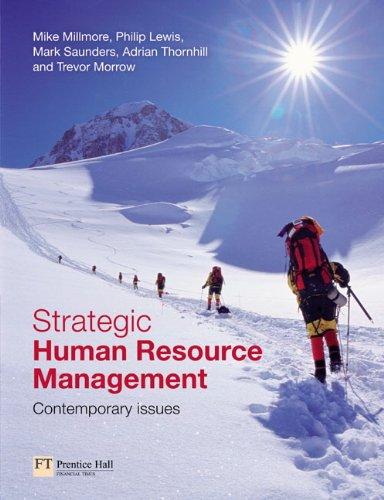In other case studies presented in this book the focus of analysis has been at the organisational
Question:
In other case studies presented in this book the focus of analysis has been at the organisational level and presented company-based cases. Managing the employment relationship in a strategic manner is important for both employers and employees, but can be a strategic issue that covers complete industries and sectors and, in exceptional cases, can have influence across complete national economies or even huge market places such as the European Union. Creating stability in the employment relationship at a national level can be of significant strategic importance. The benefits of such stability can be felt by all citizens who participate in the labour market, greater levels of job security may result, realistic increases in salaries and wages can be implemented on a regular basis, improvements in the employment relationship will occur at the workplace, company, sector, industry and national levels. Such an approach can create:
stability for both employers and employees; can allow indigenous businesses, particularly SMEs, to grow; and helps to attract and retain foreign direct investment (FDI) to the economy. In economies such as the UK, where unions still have a key role to play in many companies across a wide range of sectors, the most realistic strategic approach to developing a stable and flexible employment relationship may be through the partnership approach.
The case to be considered in this chapter focuses on social partnership in the Republic of Ireland. The reasons for choosing this case should become apparent after you have read it but there are a number of key factors which should be considered:
• There are many similarities between employee relations in the UK and Ireland, such as heavily unionised public sectors and traditional industry sectors.
• Modern private-sector industries and SMEs are largely non-unionised.
• Similarities exist in the UK and Irish governments’
approaches to employee relations.
• Both economies are locations for major indigenous and foreign companies that face significant competition from emerging economies in China and India, for example.
• Similar education levels, age and gender breakdowns exist in most workplaces in both economies.
• Dramatic shifts have occurred that result in employment moving from traditional industries to new high-technology industries and the service sector.
Context
In the early 1980s the economy of the Republic of Ireland was in crisis, the traditional industries were in dramatic decline and unemployment was at record levels. In 1986 the National Economic and Social Council (NESC) (this Irish organisation is comparable with the UK’s Economic and Social Research Council) produced a comprehensive prescription for economic recovery including most significantly, in the view of the government, the involvement of the unions. Implementation would, of course, only be possible with the agreement of the tripartite social partners – government, unions and employers. But why develop a national partnership agreement?
For the unions there were several considerations:
1. First, under a tripartite national agreement the weakest and lowest-paid members were protected by agreed minimum pay increases.
2. Second, wage dispersion in the1980s widened the gap between top and bottom, and threatened to undermine the solidarity of the TU movement.
3. Third, falling membership and increasing unemployment made leaders fear that what was happening to unions in Thatcher’s Britain might also occur in Ireland...........
Questions
1. Outline the main driving factors for the development of social partnership in Ireland.
2. Why do you think it was so important to have a tripartite agreement between the national government, employers and trade unions?
3. Why do you think it has been possible to develop and sustain social partnership in Ireland for such a long period?
4. Do you think it would be possible and/or beneficial for the UK to develop its own model of social partnership?
Step by Step Answer:

Strategic Human Resource Management Contemporary Issues
ISBN: 9780273681632
1st Edition
Authors: Mark N. K. Saunders; Mike Millmore; Philip Lewis; Adrian Thornhill; Trevor Morrow





